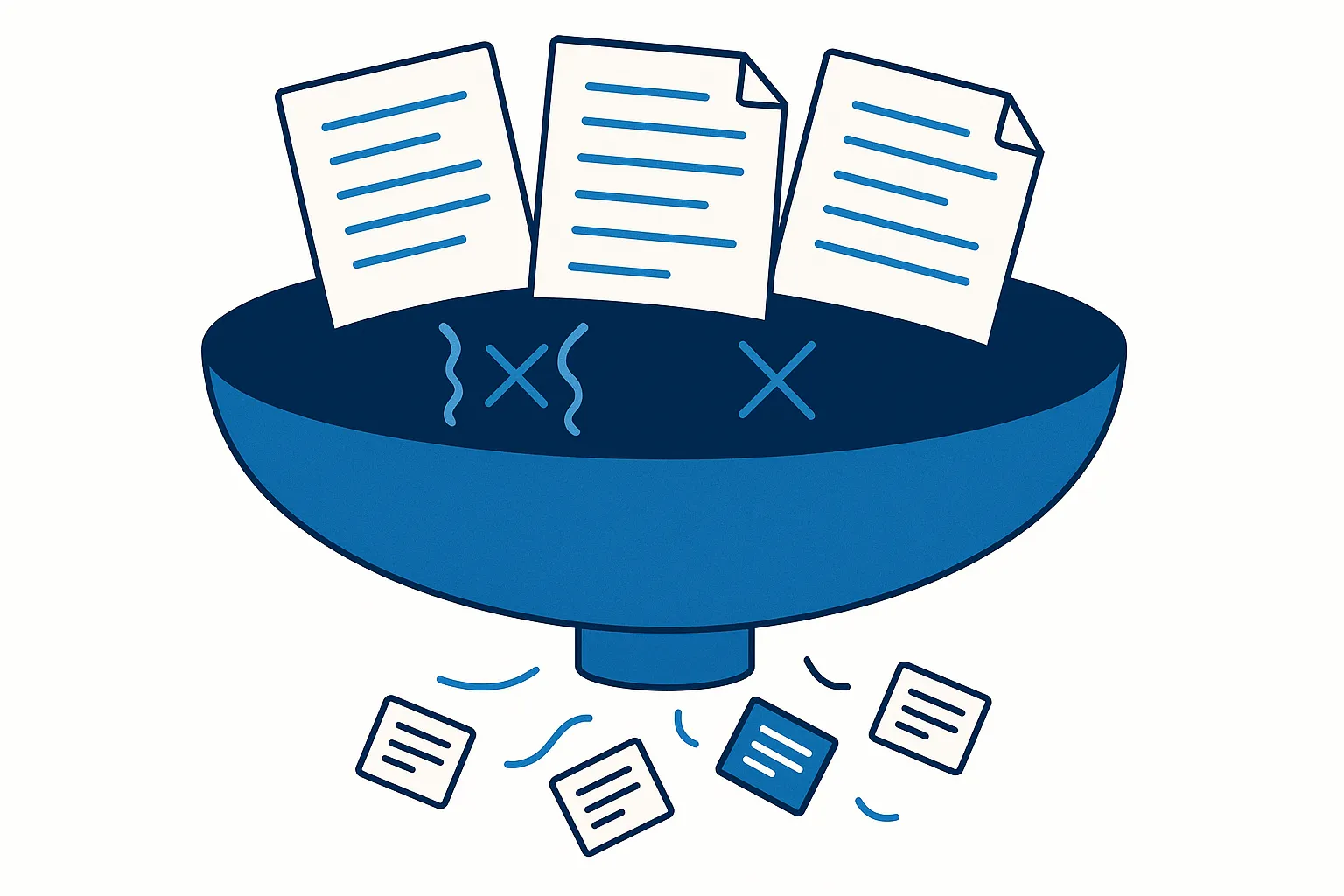Welcome back to The Precision Content Series - our focus on the key areas that help deliver precision content. In our previous post, we introduced what we mean by precision content and outlined the five pillars required to achieve it:
- Content Processing and Filtering
- Context Enrichment
- Content Workbench
- Model Selection and Optimization
- Subject Matter Expertise and Review
Today, we spotlight the often unsung hero of quality localisation: Content Processing and Filtering.
While most organizations often focus much of their effort on translation mechanics, what happens before your content reaches translators or AI systems can dramatically impact quality, efficiency, and cost.
This crucial first step involves deciding what content to include or exclude for translation, identifying or generating additional context, and determining what adaptations are required before or after translation.
Why Content Processing Matters
Consider the scenario, a global e-commerce company needs to translate its product catalog into 36 languages.
At this scale, organisations have typically invested in a Product Information Management System (PIM) and structured their content hierarchy to ease the management of the content at scale.
Without effective content processing, the following may happen:
- Translators and reviewers may waste time on common boilerplate text that could be handled through templates that can be injected into content instead.
- Product codes and metadata such as SKUs or category labels may accidentally get adjusted, either by mistake or as a by-product of machine translation.
- Context-specific product descriptions and attributes might be translated literally without cultural adaptation as the translator or AI model doesn’t know how the text relates to the overall product or product family.
- Formatting and structural elements might be altered, breaking the customer experience where the content is used.
As the content grows and markets scale, the challenges magnify exponentially, meaning any manual processes to support avoiding these becomes a more significant effort.
The good news is that much of this challenge can be overcome through effective Content Processing and Filtering.
The Components of Content Processing and Filtering
Content Processing and Filtering encompasses several critical functions that set the stage for successful localization:
Content Filtering and Segmentation
Before translation can begin, content must be properly segmented. This means it should be broken down into manageable, translatable units while preserving structural integrity.
Furthermore, not all content requires translation, and some requires special handling to ensure elements are protected and existing content re-used. Effective filtering involves:
- Structural processing: Identifying and preserving formatting, tags, and variables native to the file format. This is particularly important in handling complex content types (e.g., structured content in XML, HTML, or specialized formats like DITA).
- Exclusion rules: Identifying content that should remain in the source language (e.g. product codes, specific terminology, proper nouns, personally identifiable information).
- Inclusion rules: Identifying the content that should be included for translation. In some cases, this includes identifying bi-lingual content - i.e. what is the source content and what is the translated content in a file.
- Classification: Categorizing content by type, audience, or purpose to determine the appropriate translation approach and/or models to use.
- Encoding management: Ensuring character encodings (like UTF-8 or ASCII) and escape sequences - how the text is presented in different languages - are properly handled across different formats, as encoding requirements may differ when content moves between systems or is repurposed across multiple channels.
- De-duplication: Identifying repeated content to ensure consistency and reduce costs.
By implementing robust filtering rules, organizations can reduce unnecessary translation volume, leading to significant time and cost savings.
Context Generation and Enrichment
Given the complexity of language, context is king in translation. To ensure a high-quality translation, processing should include:
- Visual context: Generating screenshots or previews showing where text appears in the interface.
- Referential context: Providing surrounding content or related information that helps clarify meaning.
- Metadata enrichment: Tagging content with additional information about its purpose, audience, or domain.
- Term identification: Flagging key terminology that requires consistent translation.
Whilst some of the above may need up-front effort, often it can be derived at filtering time from the content itself, or and build on other assets such glossaries or context sources.
The best systems take advantage of the ability to generate file format specific context to enhance the translation process with minimal effort, providing a significant improvement from basic filtering.
Pre and Post Translation Content Adaptation
Some elements require adaptation before or after translation, often automating steps that would otherwise require intervention:
- Format conversion or adaptation: Automatically converting file formats or re-shaping content to better fit input or output formats.
- Link localization: The adaptation of links, URLs, or slugs to match the format required for a different market.
- Image or media localisation: The swapping of images or media assets to match different markets.
- Measurement conversion: Preparing content for region-specific units (imperial vs. metric)
- Date and number formatting: Ensuring compatibility with target locale conventions
- Language specific adaptations: Adjustment of content to match content rules - e.g. single character prepositions rules in Polish or Czech.
The above are just some examples of automations that can save significant effort especially at scale. With the right framework, these automations can be chained together to create powerful pipelines.
Automation and Rules Implementation
The true power of content processing emerges when the above capabilities are implemented through automated, rules-based systems that can:
- Apply consistent handling across large volumes of content.
- Reduce manual intervention and human error.
- Adapt to different content types and/or languages to allow flexibility.
Not All Processing Systems Are Created Equal
When we talk about content processing with others in the industry, often many are confused about why we focus so much effort on optimising this part of the process.
In its most basic form, ensuring the right content is extracted and protected is fundamental to translation, and is an element in every localisation solution.
Most of the solutions on the market provide filters that process a piece of content and a capability to protect pieces of text that shouldn’t be translated (e.g. placeholder variables or product SKUs).
Many however only provided limited customisation options within each filter type and off-load the rest of the adaptations required as added manual activities such as “Localization Engineering”, or leave them to the end-user outside of the tool.
Furthermore, often these rules and configurations are applied at a file type level - i.e. all Word or InDesign files - meaning that different formats across an organisation require additional effort to handle.
Whilst it may not be the most exciting feature to assess when reviewing a content platform, it can be one of the most impactful, with quality issues often tracing back to root causes triggered at this stage.
The Bridge to Context Enrichment
While content processing and filtering create the foundation of an effective translation process, it also serves as a crucial bridge to our next pillar: Context Enrichment.
These two pillars work in tandem, with effective processing creating opportunities for meaningful context enrichments.
Consider these connections:
- Structural analysis during processing identifies elements that can be provided with additional context for translators
- Content classification determines what type of context will be most valuable for different content components
- Automated tagging during processing creates hooks for attaching contextual information
- Relationship mapping between content elements enables connected context across related items
The most sophisticated processing systems are designed with context enrichment in mind, creating structured opportunities for context insertion rather than treating it as an afterthought.
Looking Ahead
Content processing and filtering is evolving from a technical necessity to a strategic advantage. Organizations that invest in this foundation see compounding returns across their global content operations.
For business and localization leaders, the key implications are clear:
- Cost Efficiency: Effective content processing reduces translation volumes through proper filtering and de-duplication, directly impacting your bottom line as content scales across markets and languages.
- Quality Assurance: Most quality issues in localized content can be traced back to inadequate processing at the initial stage—investing here prevents costly rework and brand reputation damage.
- Scalability Factor: As content volumes grow and market complexity increases, manual processing becomes unsustainable. Automated content processing enables global expansion.
- Competitive Advantage: Organizations with sophisticated content processing capabilities gain measurable advantages in speed-to-market, consistency, and customer experience across global touchpoints.
In our next installment of the Precision Content Series, we’ll explore the second pillar: Context Enrichment, in depth.
We’ll examine how context transforms translation quality, the different types of context that matter for different content, and how organizations can systematically implement context enrichment at scale.
If you’d like to stay up to date on our latest blog posts, you can subscribe to our mailing list and/or follow us on LinkedIn.

